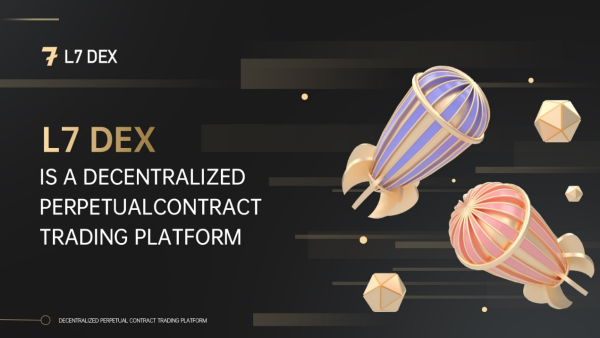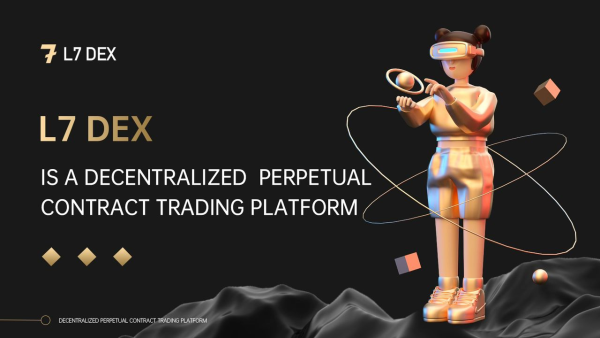L7 DEX: Exploring Something New for Decentralized Derivatives Exchanges
Abstract
L7 DEX is ushering in a paradigm shift in decentralized futures contract markets by adopting the PvP-AMM model.
Within the L7 DEX ecosystem, a novel liquidity trading model is being developed, focusing on liquidity-as-a-service.
Recognizing the higher risks associated with futures trading, L7 DEX has also introduced an order insurance (stop-loss insurance) mechanism.
In the future, L7 DEX aims to provide the market with even more straightforward and efficient investment solutions through liquidity and IEO combination.
What is L7 DEX?
Compared to centralized exchanges, decentralized exchanges (DEXs) initially had a smaller share in the futures trading market due to on-chain performance constraints. However, recent advancements in mainstream blockchains and Layer 2 solutions have propelled the decentralized perpetual futures exchange sector into the spotlight as high-frequency trading is increasingly viable.
L7 DEX is a decentralized contract trading platform based on Web3 with its major innovations of the PvP-AMM protocol, liquidity-as-a-service (LaaS), and more. The innovative PvP AMM protocol, coupled with optimized smart contracts, provides users with a seamless futures trading experience while addressing issues such as high slippage, front running, poor liquidity, and the inability to place orders, making futures trading safer, more stable, and cost-effective.

How Does L7 DEX Work?
In the DeFi sector, most protocols use automated algorithms like AMMs to balance the supply and demand of tokens in liquidity pools. However, L7 DEX introduces the PvP-AMM mechanism, bringing a paradigm shift in decentralized futures markets.
In the L7 DEX ecosystem, LP (Liquidity Provider) tokens act as an intermediary in the PvP-AMM model and are minted through depositing USDC, BTC, or ETH. These tokens can be used as collateral for perpetual futures trading or to provide liquidity to the market for a share of the protocol revenue. In particular, LP tokens are introduced to present the overall profit and loss of trades and the income and expenses of the insurance business. Here’s an example to illustrate:
Suppose Alice mints 1,000 LP tokens by depositing 1,000 USDC and opens a $10,000 long ETH position while Bob mints 2,000 LP tokens with 2,000 USDC deposits and opens a $20,000 short ETH position. Now, there are 3,000 USDC in the LP pool and 3,000 LP tokens, where 1 LP token = $1. If ETH rises by 5%, and both Alice and Bob close their positions, Alice’s balance will become 1,500 LP tokens, and Bob will have 1,000 LP tokens left. Then, there are 3,000 USDC in the LP pool and only 2,500 LP tokens, with 1 LP token = $1.2.
The specific calculation is as follows:
Alice: 1,000 + $10,000 * 5% / $1 = 1,500 LP tokens; Bob: 2,000 – $20,000 * 5% / $1 = 1,000 LP tokens
New LP Supply = Alice’s LP tokens + Bob’s LP tokens = 2,500 LP tokens
New LP Price = 3,000 USDC / 2,500 LP tokens = $1.2
In this example, we can see that the total deposits in the pool remain constant, and the profit and loss of traders are reflected in the LP token supply, inversely affecting LP token prices. This means that PvP traders are regarded as a group, and when the group profits, it drives up LP token supply and lowers token prices. Traders need to make relatively higher profits compared to the group level to earn money by trading USDT-margined futures.
Further analysis reveals that in the PvP-AMM model, the critical factor influencing profit and loss is the ratio of long positions and short positions. This allows PvP-AMM to address issues related to one-sided market conditions. It is pure Alpha trading that is less affected by market trends and doesn’t require additional liquidity providers, as traders can perform trades independently. Additionally, this model provides a combination arbitrage opportunity for API and SmartMoney, attracting new minority orders and automatically balancing the long and short ratio.
Apart from serving as initial margin in futures trading, LP tokens have several use cases: 1) Users purchase LP tokens (i.e., mint LP tokens) at the current price by depositing USDC, BTC, or ETH assets into the protocol vaults. 2) Users sell LP tokens (i.e., burn LP tokens) at the current price by withdrawing USDC, BTC, or ETH assets from the protocol vaults. 3) After purchase (minting), LP tokens enter Staking Earn.
Note: The PvP-AMM model gained industry attention primarily because of GMX’s X4 plan in 2022. However, the X4 plan was put on hold as GMX later shifted its focus to synthetic assets.
What Are the Advantages of L7 DEX Ecosystem?
Within the L7 DEX ecosystem, a new liquidity trading model centered around LaaS has been established. In this context, liquidity procurement entails acquiring liquidity from the market through a combination of “token incentives” and “transaction fee rewards”. Liquidity distribution (often through compensated means) involves providing the acquired liquidity to other entities, including institutions, project teams, or users in need of liquidity. Additionally, liquidity management includes offering liquidity management tools to project teams that have purchased liquidity, enabling them to plan their liquidity expenditure effectively. L7 DEX’s liquidity provision mechanism generates income for the platform by efficiently managing obtained liquidity while maintaining synergy between trading and the liquidity markets. This integrated approach ensures long-term financial stability and sustainable operations.
Recognizing the higher risks associated with futures trading, L7 DEX has also introduced an order insurance (stop-loss insurance) mechanism. This mechanism significantly raises the threshold for potential losses, albeit potentially sacrificing a portion of profits. Consequently, it is more suitable for long-term investors and traders with higher risk tolerance. Traders can choose to create diverse insurance strategies for the same trading asset. Different insurance ratios used in trades will generate multiple distinct positions, while trades with the same insurance ratio will be merged with existing positions. Subsequently, the PnL along with the insurance fees will be calculated. Regarding the PvP-AMM protocol, traders have the option to apply insurance to long-term trading orders, adding an extra insurance ratio that can range from 10% to 50% of the trading margin. If an order is settled or liquidated, traders who experience losses can receive compensation up to a maximum equivalent to the trading margin. Furthermore, L7 DEX’s PvP-AMM protocol calculates the PnL percentage of trading orders using an index price (derived from ChainLink and the average weighted prices from multiple CEXs). This approach helps mitigate potential issues associated with Oracle latency arbitrage.
In the future, L7 DEX aims to provide the market with even more pure and efficient investment solutions through liquidity and IEO combination. It attempts to establish an asset management and allocation system centered around LSD (L7 DEX’s native token) and other platform assets. This comprehensive system seeks to remove barriers that have previously hindered ordinary users from participating in the primary market.
L7 DEX distinguishes itself from other DeFi protocols through its innovative design mechanism, which offers liquidity providers a higher income ratio while bolstering overall system stability. Additionally, it diminishes platform token volatility and elevates the user experience within the protocol. Participants, encompassing institutions, project teams, and individual users who provide liquidity within the L7 DEX ecosystem, stand to benefit not only from trading fees and insurance fees generated by L7 DEX but also from the potential upside associated with the growth of other blue-chip project tokens within the ecosystem.

What Is the Token Mechanism of L7 DEX?
In its early developmental stages, L7 DEX has successfully cultivated synchronized growth in both its incremental and existing user base by establishing a global community and a fundamental NFT economic model. Owning an NFT within the project is akin to actively participating in its construction. Users have the opportunity to stake their NFTs and reap long-term profits, simultaneously becoming early-stage investors who benefit from the project’s growth. NFT holders can also enjoy advantages such as reduced trading fees and increased liquidity rewards. Furthermore, these users actively contribute to shaping the community and influencing the direction of product development through voting.
LSD is the native governance token of the L7 DEX platform, offering users a diverse array of utility and value-driven interactions. The total supply of LSD is 210 million tokens. In addition to its governance functionality, holding LSD offers several advantages within the ecosystem:
(1) Provide users with reduced or waived trading fees for futures trades on L7 DEX.
(2) Engage in LP mining for blue-chip projects within the L7 DEX ecosystem.
(3) Enjoy priority access to all forthcoming airdrop benefits released by L7 DEX, along with high-priority participation and early access to the platform’s future innovative products.
(4) Have the right to vote on crucial proposals within the ecosystem, with governance rights commensurate with their holdings.
(5) Gain early investment opportunities in a diverse range of distinguished projects.
Summary
In the long term, the decentralized derivatives trading sector presents significant opportunities. L7 DEX is ushering in a paradigm shift in decentralized futures contract markets by adopting the PvP-AMM model, poised to accelerate its growth. Furthermore, L7 DEX distinguishes itself through unique features such as an innovative liquidity trading model, an order insurance mechanism, and the “liquidity + IEO” development approach. These attributes bolster the protocol’s efficiency and security, making decentralized contracts more accessible and enhancing the user experience. Moreover, they act as compelling incentives, attracting a wider user base to participate in the ecosystem.
Website: https://www.l7dex.finance/
Twitter: https://twitter.com/L7_DEX
Telegram: https://t.me/L7DEX_Official
Discord: https://discord.gg/l7dex
Disclaimer: This press release may contain forward-looking statements. Forward-looking statements describe future expectations, plans, results, or strategies (including product offerings, regulatory plans and business plans) and may change without notice. You are cautioned that such statements are subject to a multitude of risks and uncertainties that could cause future circumstances, events, or results to differ materially from those projected in the forward-looking statements, including the risks that actual results may differ materially from those projected in the forward-looking statements.
Media Contact
Company Name: L7 Labs
Contact Person: Lucas wang
Email: Send Email
Country: United Arab Emirates
Website: www.l7dex.finance


